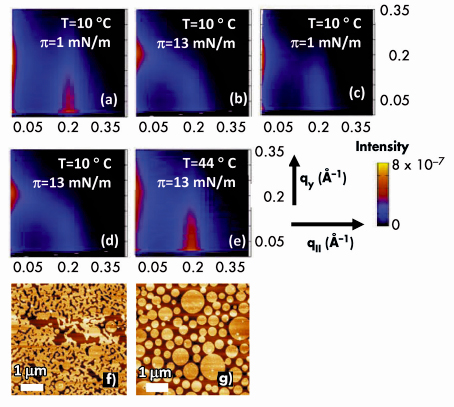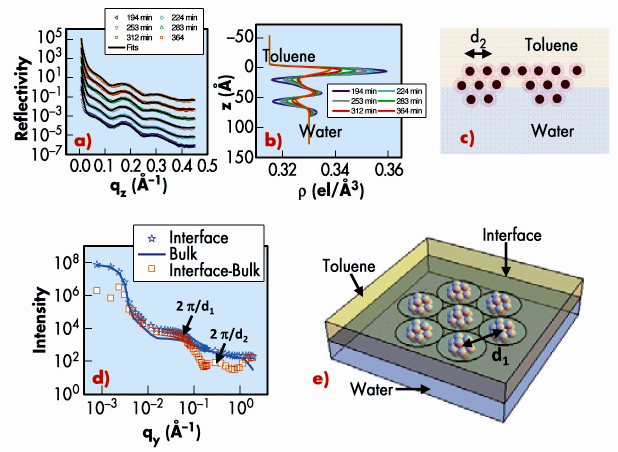- Home
- Users & Science
- Scientific Documentation
- ESRF Highlights
- ESRF Highlights 2008
- Soft condensed matter
- Formation and ordering of gold nanoparticles at toluene-water and air-water interfaces
Formation and ordering of gold nanoparticles at toluene-water and air-water interfaces
Gold nanoparticles with sizes around 2 nm and below are being studied extensively because they exhibit novel electronic, magnetic, optical and catalytic properties. We are investigating the formation of Au-55 types of gold nanoparticles through a reduction reaction at a liquid-liquid interface. Diffuse X-ray scattering and reflectivity techniques [1] allow us to monitor the formation of gold nanoparticles at liquid-liquid interface. These techniques also provide information regarding the out-of-plane and in-plane structure of the gold nanoparticles at liquid surface and liquid-liquid interface.
In situ X-ray scattering measurements were carried out at beamline ID10B during the formation of gold nanoparticles at a toluene-water interface. The reduction reaction [2] uses an organic precursor of gold kept in the toluene layer and a reducing agent kept in the slightly alkaline water layer. As the reaction occurs through the creation of fingers from one liquid to another, the size (1 nm diameter) of the nanoparticles remain monodisperse. The reflectivity data collected as the reaction progresses are shown in Figure 51a and Figure 51b with the extracted electron density profiles across the interface. The peaks in the diffuse data shown in Figure 51d and the electron density profiles obtained from reflectivity clearly show the formation of a 1.2 nm nanoparticles core with a 1 nm organic shell which reorganize amongst themselves to give 13 member clusters with nanoparticle-nanoparticle separation, d2 ~ 3 nm (Figure 51c), and cluster-cluster separation, d1 ~ 18 nm (Figure 51e). Formation of organic layers at toluene-water interface could be monitored by measuring interfacial tension that reduces by an order of magnitude through diffuse scattering arising from capillary waves. This in situ high-energy (required to go through the upper liquid) X-ray scattering technique developed here will provide us with unique information regarding asymmetric interfacial reactions important not only for formation of tiny nanoparticles but also for several biological reaction mechanism. The published result is one of the most viewed papers in American Chemical Society journals.
We are also investigating methods to improve the packing density of nanoparticles on substrates by transferring a Langmuir monolayer from a water surface. Hydrophobic thiol-capped gold nanoparticles were spread on a water surface and the ordering of these particles was studied by X-ray scattering techniques as a function of in-plane pressure and temperature. The primary purpose of this study is to understand the structure and morphology of a monolayer of thiol-capped 2 nm gold nanoparticles on a water surface over the large reversible region of isotherm (1–15 mN/m) and to develop a method to improve coverage of these nanoparticles in deposited monolayer films. Figure 52 shows (qII-qz) contour plots of the grazing incidence diffraction (GID) data collected from the monolayer at different surface pressures and temperatures. Figure 52 (a,b,c) show the bending of Bragg-rod at qz = 0.19 Å-1 with higher surface pressure (13 mN/m). The rod straightens after decompression (1 mN/m) at 10°C. The Bragg-rod is also straightened (Figure 52 (d,e)) by annealing the monolayer at 44°C. The detailed analysis of the data shows that a monolayer of gold nanoparticles exhibits reversible buckling under a compression-decompression cycle and can be annealed thermally.
 |
|
Fig. 52: The (qII-qz) contour plots of intensity at 10°C with surface pressure a) 1 mN/m, b) 13 mN/m and c) 1 mN/m after decompression. Scattered intensity at d) 10°C and e) 44°C w th 13 mN/m. AFM images of films deposited with 13 mN/m at f) 16°C and g) 33°C. |
We annealed a monolayer film at 13 mN/m from 16°C to 33°C and found that the annealed monolayer provides much more compact structures in the transferred films on a substrate. Atomic force microscopy measurements of these deposited films are shown in Figure 52 (f,g).
Principal publications and authors
M.K. Sanyal (a,b), V.V. Agrawal (b), M.K. Bera (a,c), K.P. Kalyanikutty (b), J. Daillant (d), C. Blot (d), S. Kubowicz (d), O. Konovalov (e), C.N.R. Rao (b), J. Phys. Chem. C 112, 1739 (2008); M.K. Bera (a,c), M.K. Sanyal (a), S. Pal (a), J. Daillant (d), A. Datta (a), G.U. Kulkarni (b), D. Luzet (d), O. Konovalov (e), Europhys. Lett. 78, 56003 (2007).
(a) Saha Institute of Nuclear Physics (India)
(b) Jawaharlal Nehru Centre for Advanced Scientific Research (India)
(c) S.N. Bose National Centre for Basic Sciences (India)
(d) LIONS, CEA (France)
(e) ESRF
References
[1] M.K. Sanyal, S.K. Sinha, K.G. Huang, B.M. Ocko, Phys. Rev. Lett. 66, 628 (1991).
[2] C.N.R. Rao, G.U. Kulkarni, P.J. Thomas, V.V. Agrawal, P. Saravanan, J. Phys. Chem. B 107, 7391 (2003).




